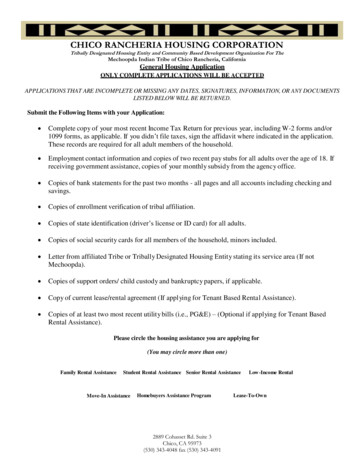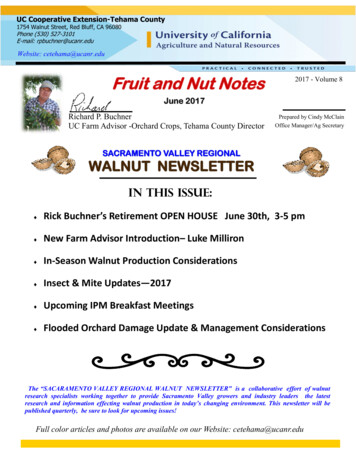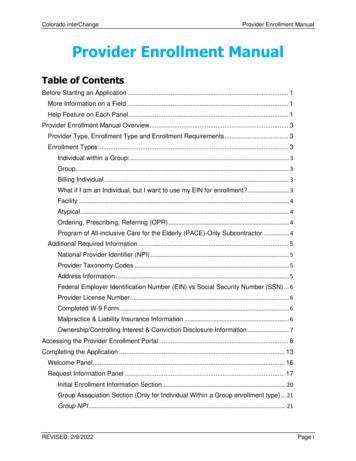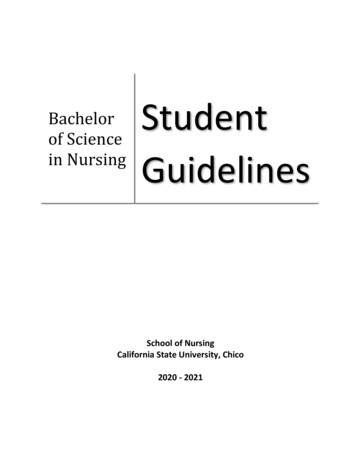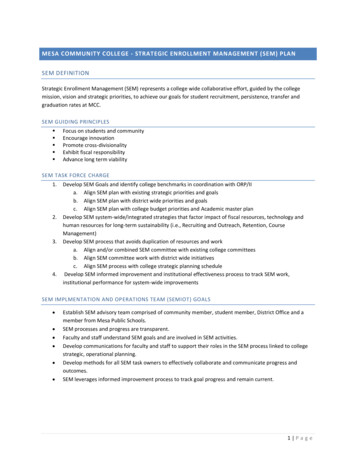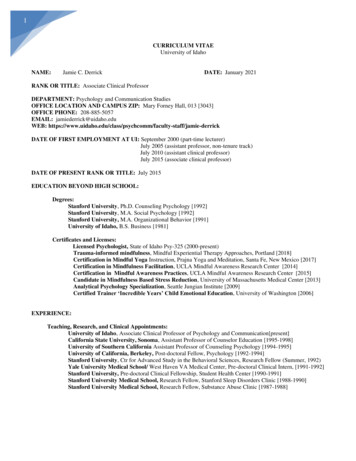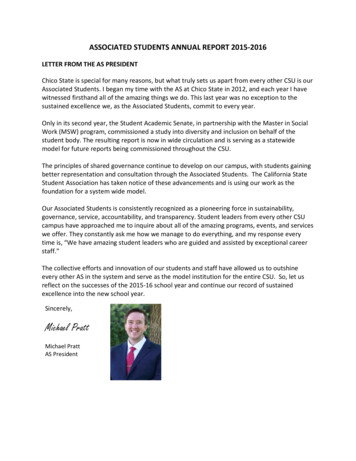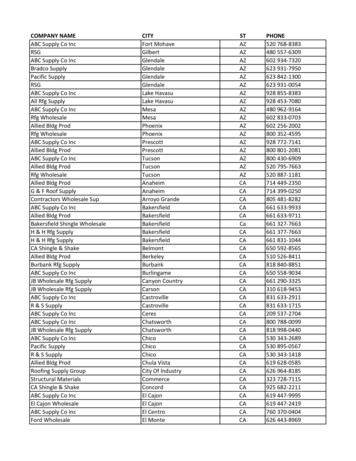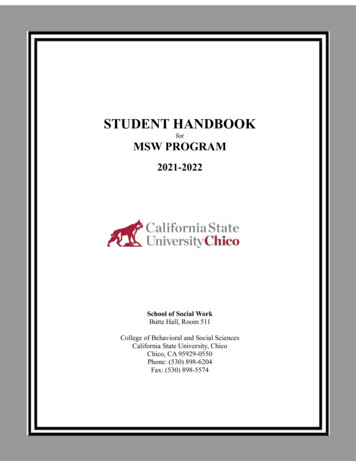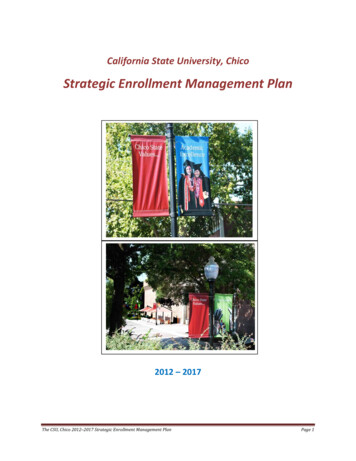
Transcription
California State University, ChicoStrategic Enrollment Management Plan2012 – 2017The CSU, Chico 2012–2017 Strategic Enrollment Management PlanPage 1
“Strategic Enrollment Management (SEM) is acomprehensive process designed to help an institutionachieve and maintain the optimum recruitment, retention,and graduation rates of students where ‘optimum’ isdefined within the academic context of the institution. Assuch, SEM is an institution-wide process that embracesvirtually every aspect of an institution’s function andculture.” (Michael Dolence, 1993.)Rev. July 9, 2013The CSU, Chico 2012–2017 Strategic Enrollment Management PlanPage 2
Table of ContentsAcknowledgments . . . . . . . . . . . . . . . . . . . . . . . . . . . . . . . . . . . . . . .4Message from the President . . . . . . . . . . . . . . . . . . . . . . . . . . . . . . . .5IntroductionVision Statement . . . . . . . . . . . . . . . . . . . . . . . . . . . . . . . . . . . .6Guiding Principles . . . . . . . . . . . . . . . . . . . . . . . . . . . . . . . . . . . .7Enrollment Profiles . . . . . . . . . . . . . . . . . . . . . . . . . . . . . . . . . .9Enrollment Projections. . . . . . . . . . . . . . . . . . . . . . . . . . . . . . . .11Challenges and Opportunities. . . . . . . . . . . . . . . . . . . . . . . . . . . 11A Framework for Strategic Enrollment ManagementElement 1: University Identity and Image. . . . . . . . . . . . . . . . . .13Element 2: Recruitment and Admission of Students . . . . . . . . . .14Element 3: Student Support Systems . . . . . . . . . . . . . . . . . . . . .15Element 4: Student Success . . . . . . . . . . . . . . . . . . . . . . . . . . . .15Element 5: Enrollment Programs and Services Improvement . . .16Element 6: Integrating SEM Infrastructure . . . . . . . . . . . . . . . . .17Enrollment Management GoalsAppendicesA: Key Performance Indicators. . . . . . . . . . . . . . . . . . . . . . . . . .18B: Other Performance Indicators . . . . . . . . . . . . . . . . . . . . . . . .19C: Additional Tables . . . . . . . . . . . . . . . . . . . . . . . . . . . . . . . . . .20D: Chico Enrollment Resources. . . . . . . . . . . . . . . . . . . . . . . . . .15E: Enrollment Management Advisory Committee . . . . . . . . . . . .33F: Definition of Terms. . . . . . . . . . . . . . . . . . . . . . . . . . . . . . . . .35G: Research on Enrollment Management. . . . . . . . . . . . . . . . . . .37The CSU, Chico 2012–2017 Strategic Enrollment Management PlanPage 3
AcknowledgmentsThe development of this Strategic Enrollment Management Plan would not have been possiblewithout the leadership provided by President Paul J. Zingg, Provost and Vice President forAcademic Affairs Belle Wei, and Vice President for Student Affairs Drew Calandrella, and theefforts of many members of the California State University, Chico campus community.For years, CSU, Chico has been building a more integrated system of enrollment management.The campus community recognized the integrated nature of enrollment management and hasmade great strides in collaborative work across its divisions. This work has resulted in recordapplications, enrollment, retention, and graduation rates. In the current effort, members ofChico’s Strategic Enrollment Management Task Force have expanded upon the earlierengagements with this core process and have focused on designing a more strategic andintentional approach to address the challenges facing higher education in general and CSU,Chico in particular.Kelley, MeredithAllen, William R.Barger, Debra E.Barrios, Sharon L.Bee, Allan C.Booth, DariaCorona, StacieFord, Richard L.Fox, Jennifer RyderLi, Frank F.Loker, William M.Mills, Russell S.Patterson, Chela M.Reed, Dan M.Roberts, ScottVice Provost of Enrollment Management -- Committee ChairInterim Director, Office of Institutional ResearchDean, Center for Regional and Continuing EducationAssociate Dean, Office of Graduate StudiesDirector, Office of AdmissionsCoordinator, Scholarship AdvancementAssociate Vice President, Business and FinanceChair, Enrollment Management Advisory Committee (2008–2012)Dean, College of AgricultureDirector, Office of International EducationDean, Undergraduate EducationChair, Academic SenateDirector, Educational Opportunity ProgramDirector, Financial Aid and ScholarshipChair, Enrollment Management Advisory Committee (2012–2013)The CSU, Chico 2012–2017 Strategic Enrollment Management PlanPage 4
Message from the PresidentColleagues:I am pleased to share with you CSU, Chico’s 2012–2017 Strategic EnrollmentManagement Plan. The plan addresses the charge I initially set for the task force thatdeveloped this plan, namely, to provide the context for and identify the elements of abroad-based plan that will institute a transparent, intentional, and integratedframework to guide us in our enrollment management efforts.CSU, Chico completed its 125th anniversary year in 2012, which saw the values of ourcampus expressed in emphatic ways, such as the My Service Counts campaign thattotaled more than 170,000 volunteer hours by students, faculty, staff, alumni, andparents. Our very successful Chico State Expo 125, which paired a community openhouse with Choose Chico!, demonstrated our long-standing commitment to the regionas well as to our prospective students. Not surprisingly, this Strategic EnrollmentManagement Plan reflects these enduring University values and builds on the successwe have enjoyed as one of the CSU’s most popular campuses.Higher education has been under unprecedented pressures to provide greater access toour institutions, ensure student learning and success, respond to rapidly changingdemographics, increase accountability, and develop greater efficiencies as we facesignificantly reduced resources, especially in the public sector. Strategic enrollmentplanning is a critical tool in responding to these pressures and overcoming them. Ourability to recruit, enroll, retain, and graduate a diverse, high-quality student body issignificantly enhanced by a dynamic and comprehensive plan that includes both a shortterm and long-term focus, and that is seen as part of an ongoing and adaptive process.A campus enrollment plan is not only mandated by the Chancellor’s Office and the CSUBoard of Trustees; it is critical, I believe, to our efforts to manage these matters. And todo so, as much as possible, on our terms and in accordance with our strategic priorities.The CSU, Chico Plan provides a unified and focused direction in order to deal with theturbulent conditions affecting higher education in general, and the CSU system inparticular, as we navigate budget cuts and a divisive political environment.I invite you to examine closely this plan and to help achieve its goals through careful andconsequential actions. The plan’s success depends not only upon a consensus ofapproval for its guiding principles and strategies, but also on broad institutionalcommitment to its implementation.Paul J. ZinggSeptember 2012The CSU, Chico 2012–2017 Strategic Enrollment Management PlanPage 5
IntroductionSince its beginnings in 1887, CSU, Chico has provided generations of students with uniqueeducational experiences built upon an inclusive learning community of faculty, staff, andstudents who live, work, and study within a rural Northern California setting. Today, CSU,Chico is one of the West’s highest-ranking public comprehensive universities. It serves notonly the local region but also the state, the nation, and the world through instruction,research, and public service. CSU, Chico’s popular motto, “Today Decides Tomorrow,”characterizes the University’s focus on student success, exemplified by its high graduationrate, strong ranking for alumni earning levels, and many national and regional awards instudent competitions. CSU, Chico is renowned for its leadership in higher education in areassuch as service, sustainability, and academic technology. It is also known for the deep affinityalumni and others have for the Chico Experience, a special sense of place, and an uncommoncommitment to student learning that sets CSU, Chico apart from many other universities.For the past few years, significant economic and political events in California as well as in theUnited States have affected public higher education enterprises. Like other universities, CSU,Chico has faced the challenges of reduced fiscal resources, increasing public expectations andneeds, and rapid innovation—especially in information technologies.In response to these challenges, CSU, Chico is developing its multiyear strategic enrollment planto better align itself with its current and, more importantly, future environment, as well as toprovide ongoing guidance for its enrollment policies, procedures, and practices. President Zingghas noted: “We choose to see the current ‘crisis’ as an opportunity to reaffirm our purposes,reset our priorities, revisit how we do business and define quality, and reestablish our publicstanding. We are convinced that if we address these challenges strategically and decisively, wecan emerge as an even stronger university and occupy our special niche in the changinglandscape of higher education for years to come. We can and we will succeed as a ‘place’ andas a ‘choice.’ ”Vision StatementCSU, Chico embraces the concept of One University, where campus community members moveboldly into the future with a common sense of purpose and resolve. We are dedicated toacademic excellence and active learning in and out of the classroom. Our University valuesreason, respect, and civility in the pursuit of knowledge; we demonstrate the importance ofservice and sustainability in our programs and policies; we successfully form engaging, diversecommunities. Our campus character is evident not only among our current students, faculty,and staff but in the actions of our alumni and retired faculty and staff; the Chico Experience is acontinuum that touches and informs all our community members, past and present. FewThe CSU, Chico 2012–2017 Strategic Enrollment Management PlanPage 6
institutions of higher learning have a more committed and loyal group of alumni and friendsthan CSU, Chico, and this affinity aids our recruitment of students year after year.Members of the Strategic Enrollment Management Plan Task Force see their efforts as part ofan ongoing planning process that engages the entire campus in strategic, forward-thinking, andintegrated planning to achieve measurable outcomes, primary among which are studentlearning and student success. They see a Strategic Enrollment Management Plan that ismultiyear, intentional, strategic, measurable, and evidence based—and allows for regularperformance monitoring and evaluation. They anticipate that the campus leadership willchampion and celebrate demonstrable results.Guiding PrinciplesThe CSU, Chico Strategic Plan for the Future and its associatedAcademic Plan provide the principles for enrollment planning,management, and decision making. The values and goalsarticulated in these planning documents embody thefollowing principles to guide our efforts of comprehensiveenrollment management:P1.P2.P3.P4.P5.P6.Recruit, admit, enroll, retain, and graduate adiverse student population.Provide the greatest access possible, particularlyto students within our service region.Ensure satisfactory student progress to degree.Commit to the academic success of all of ourstudents.Preserve our character and distinctiveness as aresidential campus.Align resources and strategic enrollment practicesat both campus and program levels.These guiding principles will be evident in the implementation of this enrollment plan, as theyrepresent the heart of the commitment we make to students at CSU, Chico.The CSU, Chico 2012–2017 Strategic Enrollment Management PlanPage 7
CSU, Chico Enrollment ProfilesThe Chico Normal School was founded in 1887 and enrolled its first classin 1889. The first class of teachers graduated in June 1891, whenenrollment stood at 90 students. The typical Chico Normal School studentwas a 17-year-old woman from Northern or Central California. Womenoutnumbered men by more than 5 to 1.In fall 2012, CSU, Chico is a vital part of the larger landscape of American higher education. Ourstudent population has grown to more than 16,000, with close to 15,000 full-time equivalentstudents (FTES).Head-count enrollments represent the number of students actively enrolled on campus by theclose of the third week of a semester. FTES is derived by dividing total semester credit hoursattempted by 15. (In 2006, the state agreed that the CSU should calculate FTES in the same wayas the University of California and the rest of the nation—12 student credit units per FTES formaster’s students rather than the 15-unit standard). The FTES calculations adjust the headcount enrollments for differences associated with having skewed distributions of either parttime or full-time students. Enrollment numbers for the past six years reflect a growth trajectorywith a sudden downturn beginning in fall 2010 in response to state budget cuts.Table 1: Total Head-Count Enrollment at CSU, ChicoCSU, Chico Head Count (Fall Semesters)Total 615571540385338Graduate835892869885915854Table 2: Total Full-Time Equivalent Students (FTES) at CSU, ChicoCSU, Chico FTES: Target vs. ActualsTotal FTES - TargetTotal FTES - ActualPercent ,688101%105%105%102%102%100%More numerous than ever are our students of color. Ten years ago, such students constituted20 percent of our freshmen enrollments in the fall; five years ago, 26 percent; this year, theyThe CSU, Chico 2012–2017 Strategic Enrollment Management PlanPage 8
represent 43 percent. This is a reflection of state demographic shifts, in the CSU, and on ourcampus (Chart 1).The fastest-growing segment of the student population, CSU Hispanic/Latino undergraduatestudents, has increased by almost 70 percent over the past decade, to about 115,000 of a totalCSU undergraduate enrollment of 367,000. Within the next two or three years, this populationwill likely become the largest ethnic group in the system.Chart 1: Freshman Enrollment by EthnicityStudents of color (SOC): African American, American Indian/Alaskan, Asian American/PacificIslander, Mexican American/other LatinoThe CSU, in other words, looks a lot like the rest of California. As this graph shows, we atCSU, Chico are too continuing to reflect the changing demographics of our state.The CSU, Chico 2012–2017 Strategic Enrollment Management PlanPage 9
CSU, Chico Enrollment ProjectionsEnrollment targets for the CSU system and individual campuses are set by the Chancellor’sOffice in response to demand, budget constraints, and the ability to maintain quality, as well asnegotiations with the governor and the state legislature. In previous administrations, the CSUnegotiated higher education compacts with the governor that provided increased enrollmentsin exchange for stable funding. There are no current compact agreements, and in fact, statefunding has decreased significantly, bringing increased student tuition/fees and forcing reducedenrollment, beginning with the 2009–2010 academic year.In projecting future enrollments, we are faced with continuing uncertainty. Table 3 below is forillustration only. International projections are based on the International Enrollment Plan.Table 3: CSU, Chico Projected Enrollment GrowthCSU, Chico Projected Enrollment GrowthTarget ,80016,058ResidentTotal FTESProjected Growth - IllustrationFrom International Enrollment Plan: 1% Resident FTES; 800 International students in 3 years; 1,200 international students in 5 yearsCSU, Chico Enrollment Challenges and OpportunitiesCSU, Chico faces significant challenges and opportunities that will frame and guide its strategicenrollment efforts over the next five years.1. Limited Demand from Our Service RegionCSU, Chico serves a 12-county service area that is one-third the size of California, with2% of the population. The population of the North State is not only sparse; its collegegoing rate has traditionally lagged that of the rest of the state (Table 10). As a result, wemust recruit students from throughout the state and beyond to meet our enrollmentgoals.The CSU, Chico 2012–2017 Strategic Enrollment Management PlanPage 10
2. Changing Demographics in the State of CaliforniaFor the foreseeable future, the State of California will continue to be characterized bypopulation growth and demographic changes along with rapidly changing technologiesand workforce transition. The changing demography of California brings attendantchallenges and opportunities. In the past few decades, most of the growth has occurredin the Hispanic and Asian populations. The California Department of Finance projectsthat by 2025 Hispanics will represent the largest ethnic group in the state. Thesocioeconomic characteristics and age structures of the state’s populations are alsochanging and affecting educational demand and outcomes. Traditionally, Hispanic,African American, Native American, and low-income populations have lower collegegoing rates.Even without increases in high school graduation rates or college-going rates, budgetedenrollments in the CSU are expected to grow at an average annual rate of 2.5 percentaccording to the CSU Strategic Planning Effort: ‘Access to Excellence.’3. Access to and Affordability of a College EducationThe foreseeable years will also see continuing fiscal challenges to publicly fundedinstitutions as demand on state funds will continue to squeeze spending on highereducation, which is discretionary. The state is having difficulty finding resources to keepits commitment to the levels of access envisioned in the Master Plan.The CSU is in its fourth year of fiscal crisis, and by the end of 2012, its state support mayhave declined by as much as a third since 2008. Compared to the Higher EducationCompact, negotiated with former Governor Arnold Schwarzenegger, this results in a 1.7 billion gap in state funding, which has forced the CSU into an increasing reliance ontuition fees. At CSU, Chico, the reliance on tuition increased from 30 percent in 2006–2007 to 53 percent of the campus budget in 2011–2012 (Chart 10). The alarming rate ofincrease in tuition fees is raising serious concerns about the affordability of a collegeeducation in general, but especially for the first-generation, low-income studentpopulation seeking the necessary postsecondary preparation to join the workforce ofthe future. Adequate preparation must include a global perspective in the learningexperiences we provide. These developments will pose special challenges for a rural,residential, comprehensive university such as CSU, Chico.4. CSU, Chico: The University of ChoiceCSU, Chico must be the institution of choice for an increasingly diverse studentpopulation. It must maintain robust enrollments to achieve its mission and secure itsfuture. It must, therefore, continue to examine its value proposition to ensure thatfuture student populations can fully participate in the Chico Experience. The Universitymust leverage its unique learning assets with insights from the learning sciences andnew technology-based tools to create engaging, personalized Chico learning experiencesThe CSU, Chico 2012–2017 Strategic Enrollment Management PlanPage 11
that look to the future as well as address the reality of its students’ daily lives. It willthus prepare its students to become gainful members of the 21st-century workforce andtake on the challenges, responsibilities, and obligations of citizenship in our democracyand beyond.The CSU, Chico 2012–2017 Strategic Enrollment Management PlanPage 12
A Framework for Strategic Enrollment ManagementThe proposed CSU, Chico framework focuses on six dimensions of strategic enrollmentmanagement—university identity and image, recruitment and admission, student supportsystems, student success, enrollment programs and services, and an integrated infrastructurefor campuswide enrollment management.1.University Identity and ImageCSU, Chico is known for excellence in facilitating student learning and fostering student success.The acknowledged reason for its existence is to enable its students to become gainful membersof the 21st-century workforce and prepare them for the challenges and obligations of globalcitizenship.For the past 125 years, CSU, Chico has been guided by the understanding that a university isfundamentally a place of people and ideas. It has succeeded because it builds and sustains adistinctive sense of place. It supports the students, faculty, and staff who comprise itscommunity. It fosters an environment of free exchange of ideas and bold imagination. It offersenriching educational experiences that deepen the sense of a distinctive Chico Experience forits students. Through cocurricular programs and a vast array of other learning opportunities—both on and beyond the campus—students can increase their levels of academic, intellectual,cultural, social and civic engagement, and personal development. This is Chico State!Goals / ActionsTo ensure its continued distinctiveness, CSU, Chico will:S1.1.S1.2.S1.3.S1.4.S1.5.S1.6.Deepen and expand the Chico Experience and make it attainable for all students.Preserve CSU, Chico’s character and distinctiveness as a comprehensive, residentialcampus.Further develop and promote a consistent CSU, Chico brand position—identity andimage.a. Expand capacity of University Advancement Creative Services for brandmanagement.b. Develop a comprehensive, campuswide marketing and communication plan.c. Develop programs to train staff and faculty on positioning initiatives.Increase commitment to social media as an ongoing communications strategy.Explore emerging technologies and media to remain relevant to current and futureaudiences.Measure and map the CSU, Chico market position relative to peers and competitors.The CSU, Chico 2012–2017 Strategic Enrollment Management PlanPage 13
2.Recruitment and Admission of StudentsCSU, Chico’s recruitment and outreach activities are designed to meet the CSU objectives ofaccess and quality as well at its goal of recruiting, enrolling, and graduating a high-quality,diverse student population. Its desired student body is viewed both as a reflection of itseducational mission and a significant indicator of its institutional health. President Zingg hasoften noted that diversity is not just an idea to express, but a community to form. “It is at theheart of what it means to be an American public university,” he says.Goals / ActionsTo promote access and quality for a high-quality, diverse student population, CSU, Chico Develop and implement multiyear student recruitment plans that increase thenumber and diversity of both domestic and international applicants forundergraduate, graduate, and distance learning programs.Enroll freshman and transfer students who are more reflective of Californiademographics.Improve the admitted to enrolled yield for admitted students of color.Become a Hispanic-Serving Institution.Expand and diversify the international student population to enhance a more globalsense of campus community.Maintain a balanced and inclusive student body—a balanced mix of undergraduate,postbaccalaureate, resident/nonresident, first-time freshmen/transfer, and onlinestudent populations in accordance with its character as a residential campuspreparing students for a global 21st century, guided by the CSU enrollment targets.Mitigate the impact of fluctuating enrollment targets through continued advocacy atthe system level, for a target that accounts for the residential nature of the campusand the impact on the surrounding community.Develop a comprehensive recruitment scholarship program as a major initiative ofthe CSU, Chico capital campaign and ongoing University Advancement program.Develop new—and maintain existing—partnerships with selected programs andinstitutions to achieve enrollment goals.The CSU, Chico 2012–2017 Strategic Enrollment Management PlanPage 14
3.Student Support SystemsCSU, Chico is committed to student success, broadly defined in terms of high levels of learning,engagement, persistence, graduation, and satisfaction. It has organized academic support andstudent services programs to ensure that students perform well academically, thrive socially,and cope effectively with nonacademic responsibilities. Its persistence rates and progress-todegree rates are among the highest in the CSU system.Goals / ActionsTo ensure continued student success—broadly defined—Chico State will:S3.1.S3.2.S3.3.S3.4.S3.5.S3.6.4.Assist all students to build academic and personal success throughout their time atCSU, Chico.Improve retention and progress-to-degree rates for all students.Reduce the existing achievement gap between underrepresented minority and nonunderrepresented students.Monitor student utilization of and satisfaction with support services.Strive to eliminate financial barriers to a CSU, Chico education.a. Provide early access to information and tools necessary for students to financetheir CSU, Chico education.b. Make timely disbursements of aid to all eligible students.c. Develop a comprehensive retention scholarship program as an element of theCSU, Chico capital campaign and ongoing University Advancement program.d. Improve the coordination and use of financial aid and scholarships to optimizeretention efforts.Utilize technology to provide enhanced 24/7 online student services support.Student SuccessCSU, Chico’s story is that of a place of learning and achievement, a place of public purpose andservice, and a place of values and value-added experiences. It is also a place of highexpectations. For students, of course, these expectations focus on academic performance. Butthey go well beyond that, beyond GPAs and GREs, awards won, and jobs secured. CSU, Chico’shigh expectations for its students include the work ethic they will embrace, how deep a senseof academic integrity they will form, how great a desire to contribute to the larger communitythey will develop, how seriously they will respect the perspectives of others, how effectivelythey will discover their own voices, how passionately they will want to shepherd our fragileenvironment, and how kindly they will respond to the needs of the weakest and leastadvantaged among us.The CSU, Chico 2012–2017 Strategic Enrollment Management PlanPage 15
Goals / ActionsTo continue its commitment to student learning and student success, CSU, Chico will:S4.1.S4.2.S4.3.S4.4.5.Improve graduation rates for all students.Reduce the existing achievement gap between underrepresented minority and nonunderrepresented students.Energize the campus intellectually and financially through innovative self-supportprograms.Monitor the success of its alumni.Enrollment Programs and Services ImprovementBeyond leading the institutional responsibility of strategic enrollment management, theEnrollment Management Services unit at CSU, Chico also manages the more traditionalfunctions of outreach, recruitment, admissions, academic advising, registration,evaluations/degree audit, and monitoring and improving enrollment management programsand services. These functions are part of CSU, Chico’s comprehensive approach to enrollmentmanagement.Goals / ActionsTo ensure continuous improvement in the effectiveness of its programs and services, Chico’sEnrollment Management unit will:S5.1.S5.2.S5.3.S5.4.S5.5.Ensure compliance with the State Education Code, Trustee Enrollment ManagementPolicy, and CSU Enrollment Management Practices.Increase the efficiency and productivity of recruitment activities througha. Application of lean thinkingb. Wise use of technologyc. Effective marketing strategiesImprove advising services and experiences for students.Exemplify quality customer service.Coordinate college/departmental recruitment efforts with larger campus efforts,including campus internationalization.The CSU, Chico 2012–2017 Strategic Enrollment Management PlanPage 16
6.Integrating Campuswide SEM InfrastructureIn his charge to the SEM Plan Task Force, President Zingg called for more strategic andintentional management of enrollment at CSU, Chico. In these challenging times for highereducation, he clearly saw strategic enrollment management planning as one of the critical toolsfor enhancing CSU, Chico’s future viability and vitality. Implementing this plan will aligncommitment, direction, and focus, and it will ensure a culture that embraces an integratedapproach to enrollment management.Goals / ActionsTo ensure implementation of CSU, Chico’s Strategic Enrollment Management Plan, the ViceProvost of Enrollment Management, in consultation with the Enrollment Management AdvisoryCommittee will:S6.1.S6.2.S6.3.S6.4.S6.5.S6.6.S6.7.Design and implement a comprehensive project management schedule for ensuringthe success of the SEM plan.Facilitate the development of multiyear project plans to establish goals, tasks,timetables, task owners, methods of evaluation, and resources required.Work with Institutional Research and Information Resources to develop a system ofdata dashboards and related databases to monitor SEM plan leading indicators andmilestones in support of evidence-based enrollment planning and decision making.Deliver and widely distribute an annual enrollment report on enrollment mattersdelineated in the SEM plan.Provide leadership and coordination for the assessment of efforts to implement thegoals and actions of the SEM p
Strategic Enrollment Management Plan . 2012 - 2017 . The CSU, Chico 2012-2017 Strategic Enrollment Management Plan Page 1 "Strategic Enrollment Management (SEM) is a comprehensive process designed to help an institution achieve and maintain the optimum recruitment, retention,

